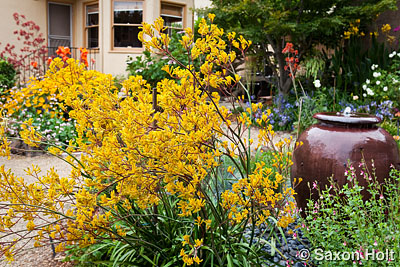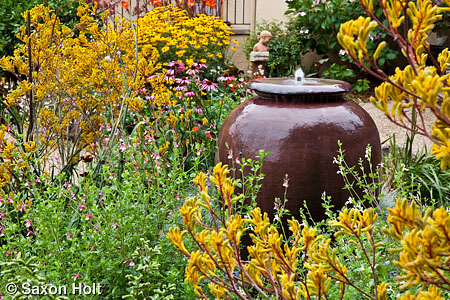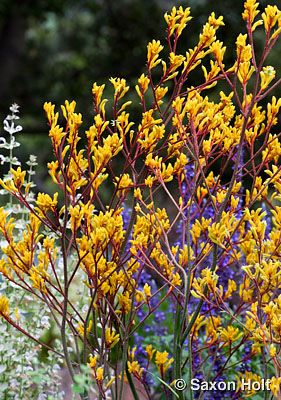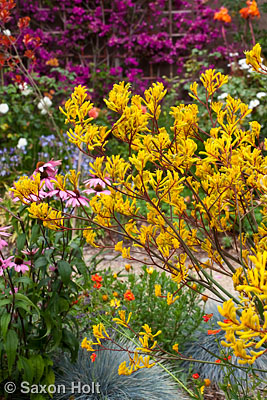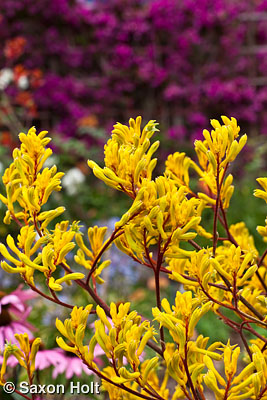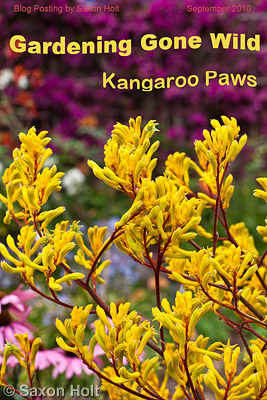As soon as I stepped out the back door of Christina’s house I knew her garden was going to provide all sorts of photo opportunities.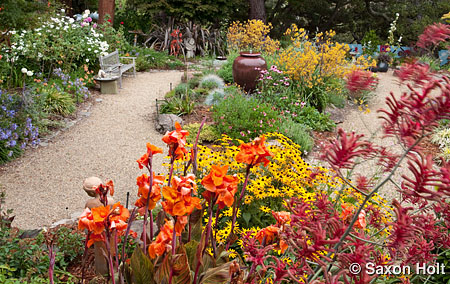
Oakland, California garden designer Sherry Merciari had referred me to Christina when I asked about gardens with no lawn, but I didn’t know what to expect. When I saw the island bed in the middle of her back yard, with gravel pathways and pockets of color still bright in the late summer . . . I scheduled a shoot immediately.
Five days later I am back. Got the front yard done and now before the light gets too hard, I rush into the back. This first photo is literally right at her back door with orange Canna and red Kangaroo Paw (Anigozanthos ‘Big Red’) growing at the back of a border and hiding the stairs of the small stoop coming out the back door. I set my camera as close to the wall as possible to get a wide view, an establishing shot to set the scene, and studied the possibilities.
Color is what was exciting me, lots more than I expected and especially the rich butter yellow of the Kangaroo Paws (Anigozanthos ‘Harmony’) at the back of the island planting. I imagined I could really accent that color by going up close to it and shooting back toward the house and the yellow Rudbeckias.
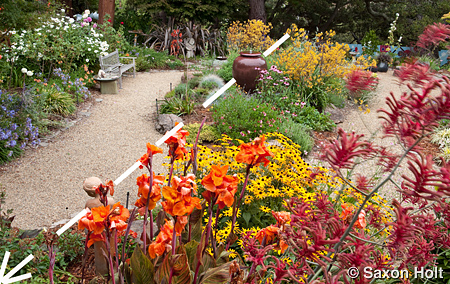 Notice the sight line that would use the urn as an element of hardscape and stack up both of the yellow color blocks.
Notice the sight line that would use the urn as an element of hardscape and stack up both of the yellow color blocks.
This is a fine and useful photo for my garden photography business. It shows lots of color, a focal point, and especially the house which can really help gardeners get a sense of scale. (Notice the back door in the upper left, which is where I first set up the camera behind the red Kangaroo Paw.) This is a fine photo but not a great one. There are several ways to make it better.
Let’s go back to that first photo and notice the small statue which is just below the back steps. Also notice there are two clumps of the ‘Harmony’ Kangaroo Paws back by the urn.
The first photo looking back toward the house did not incorporate either of those two elements and is a little boring because of it. So I slowly shifted my angle of view. Of course I wanted to keep the yellow theme but needed to improve it. I pulled back from the scene and moved to my right so as to incorporate the second Kangaroo Paw. As I did the little statue suddenly appeared in a notch above the urn.
This final composition is made studying the elements through the viewfinder, changing the lens, and making very subtle adjustments to the camera by lowering the tripod. The urn and statue need just the right relationship; the Kangaroo Paw in the upper right needs just the right balance; I want to crop out some of the house. Sweet.
As I am squatting on the path behind the island bed finishing that composition, I am scanning for more photos. Kangaroo Paws are clawing at my brain. Let’s finish this motif. One never knows how an editor will select photos and having only one sweet one will not do; especially not in this garden with so many opportunities.
Notice the dark area in the upper right of the photo ? A perfect background for tight shot of the Anigozanthos. So let’s quickly switch to a telephoto lens, back off from the Kangaroo Paw closest to me, and frame the striking flower stalks against the out of focus background.
Pretty nice that the blue Salvia drifted into the composition. But there are other colors in this garden and I now notice the maroon Bougainvillea vine on the wall of the garden, a superb complement to the maroon stems of the yellow Kangaroo Paw.
This photo works well because of the way the yellow block of color divides the photo into three triangular sections, but it doesn’t really get to the essence of the Bougainvillea / Anigozanthos interaction. So, back to my telephoto lens to isolate the only two elements that matter, the yellow Kangaroo Paws and the soft maroon background:
A classic composition. Ready made for a cover photo:

